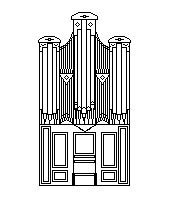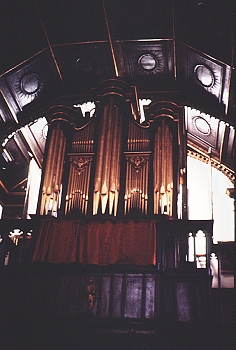  The Eighteenth Century
|
| Late Dispositions | Appearance | Review Quiz |
The Early Eighteenth Century: The SwellAt the beginning of the eighteenth century, English organs had achieved a sort of consistency of design, not to the same extent found in France, perhaps, but to such a degree that we can safely describe their general characteristics. The typical organ of the time was small by continental standards, but it was well-suited to its uses in the churches of moderate and even large size in which it was installed. Although the scheme admitted some variation, we can list these charactristics.
Early in the century, the English organ saw the first use and development of a Swell enclosure, a device that was to have long-lasting major effects on the nature of the English organ. Although details of its construction and functioning are vague, Abraham Jordan, a builder, claimed his swell box at St. Magnus, London Bridge, in 1712, was a new invention. It allowed the player to open or close a panel in the front of a box, or secondary case, that enclosed the pipes of the Echo division. 182 This innovation was quickly taken over by other builders, and "... by 1730 every average new organ in England had a swellbox;" 183 The result of this mechanical change was the development of a new division, the Swell, which soon had its own set of characteristics. By mid-century, its compass remained shorter than the Great and Choir, and its tonal characteristics included
|
| Top of Page: The Swell | Late Dispositions | Appearance | Review Quiz |
Late Eighteenth-Century DispositionsThe English organ of the second half of the eighteenth century developed from the essential characteristics of the instrument of the first half. In general, builders sought a more refined tone in the principal chorus, and a general roundness of sound seems to have been a goal. On the other hand, John Snetzler (1710- ) built instruments that were distinguished by their brilliance, perhaps because of his German background and early experience in building organs on the continent. Snetzler's name is one that should be of particular interest to you, because some of his instruments were exported to the United States. As an example of his work, consider the stoplist of the 1766 organ Snetzler built for the Halifax Parish Church in Yorkshire. Before you start reading it, I want to tell you that on a typical English organ of this period, the stop names did not include the numbers that designate pitch level. A Diapason was always an 8' stop, a Fifteenth a 2' stop, and so on, so the numbers weren't necessary. I've added them for the sake of consistency, and I hope it makes it easier for you to read them. I want you to remember, though, that I've changed the flavor of the stoplist a little in doing so.184 |
| Great GG,AA - e''' |
Choir GG,AA - e''' |
Swell g - e''' |
||||||||
|---|---|---|---|---|---|---|---|---|---|---|
| Open Diapason | 8 | Open Diapason | 8 | Open Diapason | 8 | |||||
| Open Diapason | 8 | Stopt Diapason | 8 | Stopt Diapason | 8 | |||||
| Stopt Diapason | 8 | Principal | 4 | Principal | 4 | |||||
| Principal | 4 | Flute | 4 | Cornet III | ||||||
| Twelfth | 2 2/3 | Fifteenth | 2 | Trumpet | 8 | |||||
| Fifteenth | 2 | Cremona | 8 | Hautboy | 8 | |||||
| Furniture | Bassoon | 8 | ||||||||
| Sesquialtera | Vox humana | 8 | ||||||||
| Trumpet | 8 | |||||||||
| Bass Clarion | 4 | |||||||||
| Cornet | ||||||||||
You should notice several things about this organ. Some of its characteristics relate to its past, others were more recent innovations in organ-building.
The basic stoplist and disposition of the Halifax organ is typical of many English instruments built during the second half of the eighteenth century. Only two additional features appeared later in the century. The first of these was a new stop: the Dulciana. In the middle of the eighteenth century, Snetzler brought new types of stops to England, particularly the strings like the ones being made in southern and central Germany. 187 The stop that found the most favor with the English was the Dulciana, a soft-toned cylindrical stop that soon became a standard element of English organ tonal design. The degree to which it was adopted by the English can be seen in this organ, built in 1791 by Samuel Green.188 |
| Great GG,AA - e''' |
Choir GG,AA - e''' |
Swell g - e''' |
||||||||
|---|---|---|---|---|---|---|---|---|---|---|
| Open Diapason | 8 | Dulciana | 8 | Open Diapason | 8 | |||||
| Open Diapason | 8 | Stop Diapason | 8 | Dulciana | 8 | |||||
| Stop Diapason | 8 | Principal | 4 | Stop Diapason | 8 | |||||
| Principal | 4 | Fifteenth | 2 | Principal | 4 | |||||
| Great Twelfth | 2 2/3 | Bassoon | 8 | Dulciana Principal | 4 | |||||
| Fifteenth | 2 | Sexquialtera | ||||||||
| Sexquialtera III | Trumpet | 8 | ||||||||
| Mixture II | Hautboy | 8 | ||||||||
| Trumpet | 8 | |||||||||
| Cornet IV | ||||||||||
|
As you can see, not only does a Dulciana appear at the octave on the Swell and at unison pitch on two divisions, it has also displaced the Open Diapason on the Choir division. The relative size of Choir and Swell is the second thing to notice about the stoplist. The Chair organ had originally been the second most important division on an English organ, analagous to the Rückpositiv in Germany and the Positif in France. Even when builders physically moved the division into the main case, the Choir division retained pride of place over the smaller Swell division. This balance had changed by the end of the century, though, as you can see in the stoplist above. The Swell division now has more stops than the Choir, they are of greater variety, and the defining stop of any English division -- the Open Diapason -- is no longer present on the Choir at all. The increased importance of the Swell, making it secondary only to the Great, is the last great development in English organ building in the eighteenth century, and it remains a characteristic of English organs from this date forward. |
| Top of Page: The Swell | Late Dispositions | Appearance | Review Quiz |
Appearance
|
| Top of Page: The Swell | Late Dispositions | Appearance | Review Quiz |
© 1999 James H. Cook
 The
photograph to the right is of the organ John Snetzler built for Peterhouse
College Chapel, Cambridge, in 1765. The case is typical of organs from
the second half of the eighteenth century built by Snetzler, John Pike
England, Samuel Green, and others.
The
photograph to the right is of the organ John Snetzler built for Peterhouse
College Chapel, Cambridge, in 1765. The case is typical of organs from
the second half of the eighteenth century built by Snetzler, John Pike
England, Samuel Green, and others.